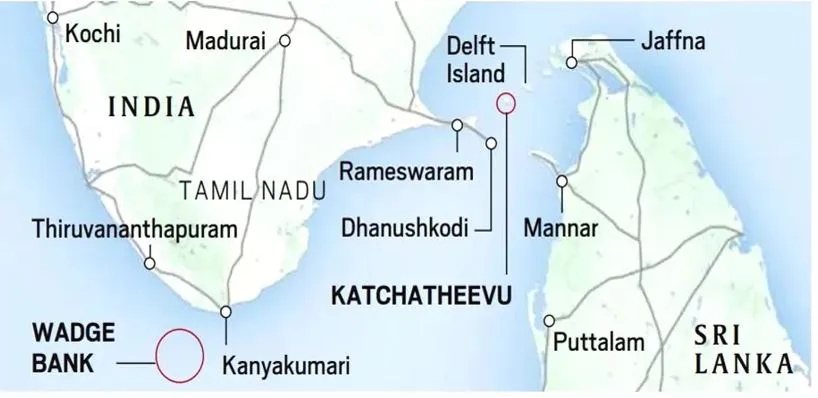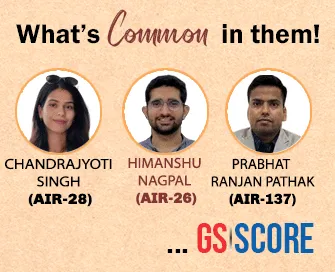

29th May 2025 (11 Topics)
Mains Issues
Context
The post of Deputy Speaker of the Lok Sabha has remained vacant since the commencement of the 17th Lok Sabha in 2019, raising concerns about constitutional non-compliance, disruption of parliamentary conventions, and the erosion of democratic principles. With no indication of appointment in the 18th Lok Sabha either, this issue has gained renewed importance.
Constitutional Mandate vs Political Reality: Understanding the Deputy Speaker Vacancy
- Constitutional Provisions Governing the Deputy Speaker:
- Article 93: Provides for the election of a Speaker and a Deputy Speaker "as soon as may be".
- Article 94: Specifies conditions under which these offices become vacant.
- Article 180(1): Allows the Deputy Speaker to act as Speaker when the Speaker’s post is vacant.
- Interpretation of “As soon as may be”
- Though no specific timeline is prescribed, the phrase signifies urgency and necessity, not discretion.
- Misuse of this ambiguity leads to prolonged vacancy, distorting constitutional intent.
Role and Significance of the Deputy Speaker
- More than a Substitute:
- Presides in the absence of the Speaker and exercises equal powers.
- Chairs vital parliamentary committees such as:
- House Budget Committee
- Private Member’s Bills Committee
- Neutral Arbiter in Sensitive Deliberations
- Expected to function above partisan interests, ensuring fair conduct of parliamentary proceedings.
- Private Member’s Bills Committee
Parliamentary Conventions and Democratic Ethics
- Convention of Allocating the Post to Opposition: Traditionally, while the Speaker is from the ruling party, the Deputy Speaker is offered to the Opposition to ensure power-sharing and harmony.
- Violation of Established Norms: Denial to offer the post to the Opposition undermines bipartisanism and damages consensus-building.
Procedural Norms Under Lok Sabha Rules
- Rule 8 of Rules of Procedure and Conduct of Business (1952)
- The Speaker is required to fix the date of election for the Deputy Speaker.
- Election occurs when a motion proposing a name is adopted by the House.
- Inconsistency with Internal Procedure
- Non-adherence to Rule 8 further violates internal governance norms of the Lok Sabha.
Implications of a Prolonged Vacancy
- Constitutional Vacuum: Risk of institutional crisis if Speaker resigns or is incapacitated without a Deputy in place.
- Centralization of Power: Concentrates parliamentary control with the ruling party, breaching the balance of power mandated by a Westminster-style democracy.
- Erosion of Accountability: Weakens legislative scrutiny, especially over the executive, and diminishes Opposition voice.
Way Forward
- Codify Timeline for Appointment: Introduce legislation or amend House rules to stipulate a specific timeframe for election of the Deputy Speaker.
- Uphold Democratic Conventions: Institutionalize the practice of allocating the Deputy Speaker’s post to the Opposition to strengthen cooperative federalism and democratic dialogue.
- Judicial Review: Supreme Court may be approached to issue directions interpreting "as soon as may be" in Article 93 to ensure time-bound compliance.


Mains Issues
Context
In a suo motu writ petition (2023) following a controversial Calcutta High Court judgment, the Supreme Court invoked its extraordinary jurisdiction under Article 142 of the Constitution to withhold sentencing of a man convicted under the POCSO Act. This case presents a landmark deviation from conventional sentencing, focusing instead on the victim’s welfare, long-term rehabilitation, and systemic reform.
Article 142 of the Indian Constitution:
- Article 142(1) of the Constitution of India endows the Supreme Court with the extraordinary power to pass any decree or order as may be necessary for doing “complete justice” in any cause or matter pending before it.
- This provision empowers the Supreme Court to transcend the constraints of statutory law when the rigid application of law results in injustice.
Scope and Purpose of Article 142
- Nature of Power: Article 142 confers a discretionary, inherent power exclusively on the Supreme Court to ensure that justice is not thwarted by procedural or legislative limitations.
- Objective: The provision is intended to enable the Court to dispense substantive justice in its fullest measure, beyond mere technical compliance with the law.
- Jurisdictional Limitation: This power can be exercised only in cases that are pending adjudication before the Supreme Court.
- Judicial Restraint: While broad, this power is not unfettered and must be exercised judiciously, respecting the constitutional framework and the basic structure doctrine.
Judicial Philosophy Underlying Article 142
- Constitutional Values: Article 142 embodies the constitutional ethos of equity, fairness, and human dignity.
- Judicial Empathy: The Court’s exercise of this power reflects an awareness of social realities and victim sensitivities, highlighting a victim-centric paradigm.
- Balancing Act: It reconciles the demands of law enforcement with the imperative to prevent further harm to vulnerable parties.
- Ethical Responsibility: The Court assumes a proactive role in safeguarding justice that transcends formal legalism without overstepping constitutional bounds.
Landmark Precedents Illustrating the Use of Article 142
- Union Carbide Corporation Case
- Utilized Article 142 to facilitate an equitable and comprehensive settlement of claims arising from the Bhopal gas tragedy.
- Ensured that justice was delivered to the victims by overcoming procedural and statutory limitations.
- Ayodhya Verdict (2019)
- Applied Article 142 to achieve a balanced and peaceful resolution of the long-standing Ayodhya land dispute.
- Directed equitable distribution of disputed land rights to maintain social harmony and justice.
- POCSO Sentencing Case (2024–2025)
- Exercised Article 142 to modify the mandatory sentencing prescribed by the POCSO Act, considering the welfare and rehabilitation of the victim.
- Emphasized a victim-centric approach by balancing statutory mandates with humanitarian concerns.
Constitutional and Legal Significance:
- Flexibility in Justice Delivery: Article 142 provides the Supreme Court with the flexibility to address gaps and unforeseen hardships not envisaged by legislative enactments.
- Complements Legislative Framework: It acts as a constitutional safety valve to correct miscarriages of justice arising from rigid statutory interpretations.
- Safeguard Against Judicial Overreach: Despite its breadth, the power is circumscribed by principles of judicial propriety and respect for separation of powers.
- Reflection of Constitutional Morality: It promotes the overarching constitutional vision of justice, liberty, and equality, especially for marginalized and vulnerable groups.
Limitations and Safeguards
- Article 142 cannot be invoked to:
- Contravene explicit statutory provisions or infringe upon fundamental rights.
- Usurp the legislative or executive functions vested under the Constitution.
- Its invocation must be justified on the grounds of necessity to achieve complete justice.
- The power should be exercised sparingly to avoid setting unwarranted precedents and maintain judicial legitimacy.
Protection of Children from Sexual Offences (POCSO) Act, 2012:Background and Objective
Salient Features of the Act
Important Provisions:
Implementation Gaps and Challenges
|
PYQ:
|


Mains Issues
Context
The Cabinet Committee on Economic Affairs (CCEA), chaired by the Prime Minister, has approved the Minimum Support Prices (MSP) for 14 Kharif crops for the 2025–26 marketing season. This step aligns with the government's commitment to offer remunerative prices and promote crop diversification under the vision of doubling farmers’ income.
Minimum Support Price (MSP)
- MSP is not a statutory or constitutional right; it is an administrative mechanism.
- No legal obligation exists on the government to procure all crops at MSP, except for crops under Public Distribution System (PDS) and welfare schemes.
- MSP policy operates under the broader umbrella of government efforts to ensure price support and food security under the Directive Principles of State Policy (Article 38, 39(b)).
Nodal Institutions Involved
- Commission for Agricultural Costs and Prices (CACP): Recommends MSPs. It is an attached office of the Ministry of Agriculture and Farmers Welfare.
- Cabinet Committee on Economic Affairs (CCEA): Final authority to approve MSPs.
- Food Corporation of India (FCI) and state agencies: Key procurement bodies implementing MSP procurement for rice and wheat.
Coverage of Crops Under MSP
- 22 Mandated Crops:
- 14 Kharif Crops: Paddy, maize, bajra, jowar, ragi, tur, urad, moong, groundnut, soyabean, sunflower, cotton, sesamum, nigerseed.
- 6 Rabi Crops: Wheat, barley, gram, lentil, mustard, safflower.
- 2 Commercial Crops: Copra and raw jute.
- Sugarcane: FRP (Fair and Remunerative Price), not MSP, is declared for sugarcane.
Cost Concepts Used by CACP
- A2: Actual paid-out costs incurred by farmers.
- A2+FL: A2 plus imputed value of family labour.
- C2: A2+FL + rent and interest on owned land and capital assets (used as a reference cost).
- MSP returns are primarily calculated over A2+FL, though C2 acts as a benchmark for ensuring viability.
Objectives and Significance
- It ensures price stability and remunerative returns for farmers.
- It acts as a risk-mitigation tool against market fluctuations.
- It aids in fulfilling the goals of food security and self-sufficiency.
- It promotes crop diversification and encourages cultivation of pulses and oilseeds.
- It serves as a buffer against rural distress, particularly during inflationary or deflationary phases.
Major Concerns and Challenges
- Limited Coverage and Implementation
- Only rice and wheat benefit from extensive procurement.
- For other crops, MSP exists only on paper; procurement infrastructure is weak or absent.
- Low Awareness and Access:
- Majority of small and marginal farmers are unaware of MSP or lack access to procurement centres.
- Shanta Kumar Committee (2015): Only 6% of farmers benefit directly from MSP.
- Regional and Crop Imbalance
- Punjab-Haryana-centric procurement leads to monoculture of rice and wheat.
- This exacerbates groundwater depletion, overuse of fertilisers, and environmental degradation.
- Role of Intermediaries
- Farmers depend on APMC middlemen and commission agents, who often exploit them by offering lower prices or extracting commissions.
- Fiscally Unsustainable
- Massive government expenditure for procurement, storage, and distribution under the PDS.
- Leads to food grain stocks exceeding buffer norms, causing storage losses and food wastage.
Reform Proposals and Way Forward
- Rationalise MSP Mechanism
- Link MSP only to food security crops and expand to underrepresented regions and crops (like pulses, oilseeds, millets).
- Diversify Crop Basket
- Provide incentives and procurement support for coarse grains and climate-resilient crops to promote nutritional and ecological sustainability.
- Strengthen Procurement Infrastructure
- Enhance the reach of procurement centres in eastern and central India.
- Ensure real-time payment systems and direct benefit transfers to farmers.
- Reduce Dependence on Middlemen
- Encourage Farmer Producer Organisations (FPOs), cooperatives, and direct market linkages.
- Legal Guarantee for MSP (Debated)
- While some stakeholders demand a legal guarantee for MSP, others argue it would distort the market and fiscal health unless backed by reforms.
Commission for Agricultural Costs and Prices (CACP):Background and Evolution
Objective and Mandate
Cabinet Committee on Economic Affairs (CCEA):Introduction & Background
Key Functions and Responsibilities
|
PYQ:
|


Mains Issues
Context
The World Meteorological Organization (WMO) has released its latest decadal climate prediction, indicating a high probability that global temperatures will remain at or near record levels during the period 2025–2029. The projections underscore the increasing likelihood of breaching the 1.5°C warming threshold, even if temporarily, with significant implications for ecosystems, human livelihoods, and the achievement of the Paris Agreement objectives.
Key highlights of report:
Decadal Climate Projections and Global Warming Trends
- Probabilistic Temperature Forecasts for 2025–2029
- There is an 80% probability that at least one year between 2025 and 2029 will surpass 2024, which currently holds the record for the warmest year.
- An 86% probability exists that at least one year in the same period will record a global mean temperature of over 5°C above pre-industrial levels (1850–1900 baseline).
- There is a 70% probability that the five-year mean global warming during 2025–2029 will exceed 5°C, up from 47% in the 2024–2028 forecast.
- Central estimate for 20-year global warming (2015–2034): 44°C with a confidence interval of 1.22°C to 1.54°C.
- Importance of the 1.5°C Threshold in Climate Agreements
- The Paris Agreement (2015) aims to limit global temperature rise to well below 2°C, ideally to 5°C, above pre-industrial levels.
- Temporary breaches of the 1.5°C threshold are expected to become increasingly frequent and are viewed as precursors to potentially irreversible climatic tipping points.
Regional Climate Implications and Specific Projections
- Arctic Amplification and Its Global Consequences
- Arctic warming during November–March (2025–2029) is projected to exceed three and a half times the global mean, with temperature anomalies estimated at +2.4°C over the 1991–2020 average.
- The amplification accelerates polar ice melt, contributing to sea-level rise and disruption of global weather systems.
- Decline in Sea Ice Cover
- Model simulations indicate reductions in sea ice concentration in key Arctic seas—Barents, Bering, and Sea of Okhotsk—during March months across the forecast period.
- This trend exacerbates the albedo effect, further intensifying global warming.
- Shifts in Global Precipitation Patterns
- Wetter-than-average conditions are projected in Sahel, Northern Europe, Alaska, and Northern Siberia.
- Conversely, drier-than-average conditions are forecast for the Amazon Basin, with serious consequences for the region’s carbon sink function and biodiversity.
- South Asia is expected to witness above-average precipitation, although intra-seasonal variability will persist, complicating agricultural planning.
Projected Impacts and Socioeconomic Consequences
- Intensification of Climate-Related Disasters
- The continued rise in global temperatures is likely to cause more frequent and severe heatwaves, floods, droughts, glacial retreat, and sea-level rise.
- These phenomena directly affect food security, water availability, disaster preparedness, and public health
- Developmental and Economic Disruptions
- Adverse climate conditions threaten progress on multiple Sustainable Development Goals (SDGs), notably:
- SDG 13 – Climate Action
- SDG 2 – Zero Hunger
- SDG 6 – Clean Water and Sanitation
- Impacts are disproportionately severe in vulnerable and low-income regions, exacerbating existing inequalities.
- Adverse climate conditions threaten progress on multiple Sustainable Development Goals (SDGs), notably:
Institutional Response and Global Climate Governance
- Role of WMO and IPCC in Climate Monitoring
- The World Meteorological Organization (WMO) synthesizes forecasts from global climate centres to assist policymakers with evidence-based decision-making.
- The Intergovernmental Panel on Climate Change (IPCC) defines global warming in terms of 20-year averages and provides central estimates along with confidence intervals for long-term tracking.
- Relevance of COP30 and Nationally Determined Contributions (NDCs)
- The upcoming COP30 will play a pivotal role in evaluating updated Nationally Determined Contributions (NDCs).
- These revised commitments are essential to align national actions with the 5°C and 2°C goals under the Paris Agreement framework.
Implications for India
India is acutely vulnerable to climate change due to its dependence on monsoon cycles, glacial water sources, and coastal settlements.
- Erratic precipitation could disrupt agricultural productivity and affect rural livelihoods.
- Accelerated glacier melting in the Himalayas threatens water security for major river systems.
- Rising sea levels endanger coastal infrastructure, biodiversity, and human habitations, especially in cities like Mumbai, Kolkata, and Chennai.
Policy Recommendations
- Enhancing Climate Resilience in Agriculture
- Promotion of climate-smart agriculture, drought-resistant crop varieties, and robust irrigation infrastructure.
- Urban Climate Adaptation Measures
- Integration of heatwave action plans, urban afforestation, and sustainable drainage systems into city planning.
- Strengthening Climate Institutions and Finance
- Investment in domestic climate modeling and early warning systems (e.g., IMD, NCMRWF).
- Increased international climate finance for mitigation and adaptation under the principle of common but differentiated responsibilities.
- Diplomatic Engagement and Global Advocacy
- India must assert leadership by advocating climate justice at COP30 while implementing its updated NDCs (2022), including commitments to non-fossil energy sources and emissions intensity reduction.
Paris Agreement (2015):
Arctic Amplification:
Nationally Determined Contributions (NDCs):
|
PYQ:“Describe the major outcomes of the 26th session of the Conference of the Parties (COP) to the UNFCCC. What are the commitments made by the international community to combat the global warming? Explain.” (2022) |


Prelims Articles
Context
Vishwanath Karthikey Padakanti, a 16-year-old from Hyderabad, has become the youngest Indian and the second youngest globally to complete the prestigious 7 Summits Challenge. He achieved this feat by successfully scaling Mount Everest on 2025, marking a remarkable milestone in Indian mountaineering.
Seven Summits Challenge:
- The Seven Summits Challenge refers to climbing the highest mountain peak on each of the seven continents.
- These include:
- Asia – Mount Everest (8,848 m)
- South America – Aconcagua (6,962 m)
- North America – Denali (6,190 m)
- Africa – Kilimanjaro (5,895 m)
- Europe – Mount Elbrus (5,642 m)
- Antarctica – Mount Vinson (4,892 m)
- Australia (Oceania) – Puncak Jaya/Carstensz Pyramid (4,884 m) or Mount Kosciuszko (2,228 m) depending on classification.
Significance for India:
- Vishwanath Karthikey is now the youngest Indian to complete this challenge, surpassing Kaamya Karthikeyan who achieved it at age 17.
- The youngest globally remains Jordan Romero (USA) who achieved it at 15 years.
- It reflects India’s growing prominence in adventure sports and extreme endurance disciplines.


Prelims Articles
Context
Tamil Nadu Chief Minister M.K. Stalin stressed that reclaiming Katchatheevu Island is essential to permanently resolve the hardships faced by the state’s fishermen. He highlighted various welfare initiatives and urged the Union Government to facilitate the release of fishermen arrested in Sri Lankan waters.
Location and Physical Features
- Katchatheevu is a 285-acre uninhabited island located in the Palk Strait between India and Sri Lanka.
- Geographical coordinates:
- Approximately 33 kilometers northeast of Rameswaram (India).
- Approximately 62 kilometers southwest of Jaffna (Sri Lanka).
- The island is unsuitable for permanent habitation due to the absence of potable water.
- The only permanent structure on the island is St. Anthony’s Church, an early 20th-century Catholic shrine, where annual festivals are conducted by Indian and Sri Lankan priests.

Historical Context
- The island is believed to have been formed by volcanic activity in the 14th century.
- Historically, it was under the jurisdiction of the Jaffna Kingdom (Sri Lanka) and later came under the control of the Ramnad Zamindari, administered by the Nayak dynasty of Madurai (India).
- During British colonial rule, it was administered as part of the Madras Presidency.
Legal and Diplomatic Developments
- 1974: Under the Indo-Sri Lankan Maritime Boundary Agreement, India formally recognized Sri Lanka’s sovereignty over Katchatheevu.
- 1976: A subsequent agreement restricted fishing in each other’s Exclusive Economic Zones (EEZs), with Katchatheevu located near the maritime boundary, leading to ambiguity over fishing rights.
- The 1974 agreement allowed Indian fishermen to access the island for non-commercial purposes, such as resting, drying nets, and attending religious festivals, but did not explicitly permit fishing.
Katchatheevu Island DisputeCore Issues in the Dispute
Positions of Key StakeholdersTamil Nadu Government
Union Government of India
The matter is currently pending adjudication before the Supreme Court. |
United Nations Convention on the Law of the Sea (UNCLOS), 1982Overview:
Maritime Zones under UNCLOS:Baseline:
Internal Waters:
Territorial Sea:
Contiguous Zone:
Exclusive Economic Zone (EEZ):
High Seas:
|
PYQ:With reference to the United Nations Convention on the Law of the Sea, consider the following statements:
Which of the statements given above are correct?
|


Prelims Articles
Context
The Government has notified Rules under the Inter-Services Organisations (Command, Control and Discipline) Act, 2023, to enhance jointness and command efficiency among the Armed Forces. These Rules empower commanders of ISOs to exercise discipline and administrative control over personnel, enabling streamlined functioning and faster resolution of disciplinary cases.
Inter-Services Organisations (Command, Control and Discipline) Rules, 2025
Background:
- The rules have been framed under the Inter-Services Organisations (Command, Control and Discipline) Act, 2023.
- Aim to enhance effective command, control, and functioning of Inter-Services Organisations (ISOs), promoting greater jointness among the Indian Armed Forces.
Purpose:
- Strengthen coordination and integration between the Army, Navy, and Air Force within ISOs.
- Ensure efficient administration and discipline.
- Avoid duplication in disciplinary proceedings and enable swift resolution.
Key Provisions:
- Disciplinary and Administrative Powers:
- Commander-in-Chief (CiC) of a Joint Services Command (JSC),
- Officer-in-Command (OiC) of an Inter-Service Establishment,
- Commanding Officer (CO) of an Inter-Services Unit,
- All hold full disciplinary and administrative authority over personnel attached to their respective ISOs.
- Residuary Powers:
- Any matters not explicitly covered under the powers of CiC, OiC, or CO shall be referred to the Central Government.
- Constitution of ISOs:
- The Central Government can constitute ISOs headed by a CiC or OiC.
- These organisations comprise personnel from at least two of the three services: Army, Navy, and Air Force.
- Superintendence:
- The Central Government maintains overall superintendence over ISOs.
- It can issue directives based on national security, general administration, or public interest.
- Role of Commanding Officer (CO):
- The CO commands a unit, ship, or establishment within the ISO framework.


Prelims Articles
Context
A recent study in Science Immunology has revealed that TR1 cells, a subtype of CD4+ T-helper cells, play a dominant role in the immune response to malaria, challenging the previous belief that TH1 cells were the primary responders. This discovery could lead to new approaches for developing vaccines and therapies for malaria and other challenging infections.
TR1 Cells
- TR1 Cells (Type-1 Regulatory T cells) are a subset of CD4+ T cells known for their immunosuppressive functions, primarily mediated by the secretion of IL-10 (Interleukin-10).
- These cells are important for tolerogenic immune responses, maintaining immune homeostasis, and preventing excessive inflammation.
- However, TR1 cells are present in low frequencies in peripheral blood (~1-10% of memory CD4+ T cells), making their ex vivo isolation and expansion a challenging task.
Clinical Applications & Preclinical Models:
- Tolerogenic TR1 Cell Therapy (T-allo10):
- A clinical-grade product called T-allo10 has been developed by co-culturing allo-HSCT (Allogeneic Hematopoietic Stem Cell Transplantation) donor CD4+ T cells with DC-10 cells from the transplant recipient.
- This therapy aims to prevent Graft-versus-Host Disease (GvHD) by promoting alloantigen-specific tolerance.
- T-allo10 is currently undergoing Phase I clinical trials to assess its potential in preventing graft rejection and promoting immune tolerance in transplant patients.
Applications in Clinical Settings
- Preventing GvHD:
- Graft-versus-Host Disease (GvHD) is a major complication in allogeneic stem cell transplantation. TR1-enriched cell therapy can induce immune tolerance and prevent GvHD.
- T-allo10 Cells: Co-culture of recipient monocyte-derived DCs with donor CD4+ T cells has shown promising results in preventing GvHD in preclinical studies.
- Anti-Leukemia Therapy:
- TR1-like CD4IL-10 cells have been tested for anti-leukemia effects, particularly in AML patients undergoing allo-HSCT. The engineered cells target leukemia cells while maintaining immune tolerance.


Editorials
Context
The discovery of Metabolic Dysfunction-Associated Fatty Liver Disease (MAFLD) in 84% of Hyderabad’s IT workforce has spotlighted India's growing health crisis, where rising non-communicable diseases now coexist with persistent undernutrition. This dual burden highlights the urgent need for a comprehensive, preventive public health strategy.
Urbanization and the Emerging Nutritional Shift
- Reflects the Coexistence of Dual Malnutrition: India’s cities present a paradox where urban affluence and economic growth have failed to eliminate undernutrition, while simultaneously giving rise to obesity and metabolic syndromes. In many states, districts with high stunting rates now report increasing incidences of adult-onset diabetes and fatty liver disease.
- Links Work Culture to Nutritional Disorders: The rise of urban-centric, tech-driven professions—especially in the IT sector—has led to prolonged screen time, high stress, and poor dietary habits. These factors reinforce the earlier dual burden by pushing individuals from undernutrition to overnutrition, often without an intervening phase of balanced dietary transition.
- Shows Higher NCD Risk in Productive Age Groups: As sedentary work styles take hold, national data confirm that middle-aged men in higher income brackets (40–49 years) are among the most affected by obesity and NCDs. This linkage between work culture and lifestyle disease challenges the idea that economic advancement alone can ensure public health improvements.
Public Health Deficits and Inadequate Preventive Measures
- Reveals Gaps in Disease Management Outcomes: Despite efforts like mass screenings under Ayushman Bharat, states such as Tamil Nadu report low rates of disease control—only 16% of hypertensive patients and under 10% of young diabetics are effectively managed—suggesting that the health system is reactive rather than preventive.
- Highlights Inadequate Dietary and Physical Habits: The lack of disease control is directly connected to poor lifestyle choices—94% of surveyed individuals consume insufficient fruits and vegetables, and nearly one-fourth are physically inactive. These habits are often rooted in urban work-life imbalances highlighted in Part I.
- Attributes Health Risks to Food Environment Failures: These poor lifestyle habits are reinforced by an unhealthy urban food environment, saturated with ultra-processed foods and limited regulation. The weak enforcement of FSSAI's Eat Right India campaign allows junk food to proliferate, exacerbating both undernutrition (via micronutrient deficiency) and NCDs (via caloric excess).
Global Models and India’s Path Forward
- Use of Fiscal Measures for Food Reform: To correct the food environment failures discussed earlier, taxation on high-sugar, high-salt, and high-fat foods can disincentivize consumption. Like tobacco taxes, such fiscal tools can help finance public health initiatives and steer consumers toward better choices.
- Need for Front-of-Pack Labelling: Fiscal measures must be complemented by mandatory and comprehensible food labelling, especially for urban populations inundated with fast food choices. Clear warnings on sugar or salt content enable consumers to act on the awareness raised by the taxes.
- Cross-Sectoral Structural Reforms: For sustained change, India needs a Vision 2030-style inter-ministerial approach, combining urban planning, nutrition regulation, and public education. Just as the food environment shapes personal health behaviour, cross-sectoral policy must shape the environment to enable healthier choices.
Practice Question:
Q. India faces the dual challenge of undernutrition and rising non-communicable diseases, particularly in urban areas. Discuss the socio-economic and systemic drivers behind this paradox, and suggest a multi-pronged public health approach to address it.


Editorials
Context
India and Germany mark 25 years of their strategic partnership, a relationship founded on shared democratic values, economic resilience, and environmental stewardship. This milestone provides an opportunity to evaluate the evolution and future trajectory of bilateral ties built upon four critical pillars: peace, prosperity, people-to-people connections, and sustainable development.
Political and Strategic Engagements for Global Stability
- Bilateral Trust through Intergovernmental Consultations: The Indo-German Intergovernmental Consultations (IGC), held every two years since 2011, institutionalise dialogue and policy alignment at the highest political level, fostering predictability and strategic coordination.
- Defence Cooperation through Joint Exercises: Initiatives like Tarang Shakti 2024 and bilateral naval visits reflect a growing Indo-Pacific synergy, embedding Germany’s security calculus into India's regional interests while promoting operational interoperability.
- Industrial Collaboration in Defence Production: The partnership is transitioning towards joint R&D, co-production, and technology transfers in defence manufacturing, reinforcing India’s goal of Atmanirbharta and Germany’s export-oriented defence strategy.
Economic Synergies and Technology-Driven Growth
- Inclusive Prosperity Beyond GDP Metrics: With over 2,000 German companies employing 750,000 Indians, economic ties now drive skill development and industrial capacity in sectors like automotive, green hydrogen, and electronics.
- Trust through Flagship Infrastructure Projects: The Delhi–Meerut Rapid Rail, operated by Deutsche Bahn, exemplifies long-term German commitment and sets benchmarks in urban transport modernisation and technological confidence.
- Deeper Trade and Research Collaboration: The proposed India–EU Free Trade Agreement and ongoing bilateral cooperation in AI, green tech, and resilient supply chains are set to elevate economic relations into strategic tech alliances.
Cultural, Academic, and Environmental Linkages
- Human Capital Exchange through Diaspora and Education: Over 50,000 Indian students—the largest international group in Germany—foster academic diplomacy, skills mobility, and the creation of transnational innovation ecosystems.
- Cultural Reciprocity and Linguistic Engagement: While many Indians study German, efforts to encourage Germans to engage with Indian languages and culture are essential for mutual respect and cultural balance in bilateral relations.
- Climate Action via the Green and Sustainable Development Partnership: Germany’s €10 billion commitment under the Indo-German GSDP (2022) supports renewable energy, biodiversity, and urban green infrastructure, reinforcing both nations' commitment to climate justice and SDG targets.
Practice Question:
Q. Indo-German relations reflect a unique model of strategic partnership that balances geopolitical, economic, and environmental cooperation. Critically examine the progress of this relationship over the past 25 years and evaluate the emerging opportunities and challenges in its next phase.


Editorials
Context
The implementation of the National Education Policy (NEP) 2020 has led to significant reforms in the Indian education and research ecosystem, with a focus on enhancing employability, fostering innovation, and global competitiveness. The editorial evaluates its impact on industry-academia linkages, R&D outcomes, and employment indicators, especially in the post-2018 period.
NEP 2020: Aligning Education with Innovation, Industry, and Employment
- Enhancing Employability Through Structural Academic Reforms
- Four-Year UG Degree Structure with Exit-Entry Options: NEP’s flexible four-year undergraduate programme allows students to exit with recognized certifications, helping them re-enter and complete education later, and pursue multi-career pathways. This is especially useful for students from disadvantaged backgrounds.
- Vocationalisation and Internships for Practical Exposure: Under NEP, 167 universities and 59 colleges have implemented the four-year UG programme; 197 universities and 93 colleges offer internships, with over 6 lakh students placed—bridging the gap between theory and real-world skills.
- Integrated Apprenticeships for Diploma Holders: NEP allows diploma students and early-exit degree candidates to take up apprenticeships within five years, offering stipends and real-time industry training—co-funded by the government—to enhance job-readiness.
- Strengthening Research, Innovation, and Global Positioning
- Expansion of R&D Infrastructure in Higher Education: Post-NEP, R&D cells have been established in 242 universities and 113 colleges, aimed at creating a culture of grassroots innovation and scientific inquiry.
- Spike in Patents and Global Innovation Index Ranking: Patents filed by Indian higher education institutions grew from 7,405 in 2021–22 to 19,155 in 2022–23, marking a 158% increase, while India rose to 39th position in the Global Innovation Index, compared to 76th a decade ago.
- Global Collaboration Through SPARC and ANRF: Schemes like SPARC and Anusandhan National Research Foundation (ANRF) Act, 2023 have enabled collaborations with institutions from 28 countries, strengthening the global visibility of Indian research and improving discipline-wise QS rankings.
- Emerging Trends in Employment and Workforce Quality
- Post-2018 Employment Recovery Among Educated Youth: The employment among educated youth (15–29 years) improved from 2018–19 onwards, with 2023–24 employment rates at 4% for men, 22.7% for women, and 38.6% overall, signaling recovery from earlier decline.
- Shift Toward Regular and Formal Employment: From 2004–05 to 2023–24, regular male employment rose from 17.2% to 24.88%, while casual female labour fell from 30.31% to 16.68%, indicating a shift from irregular to structured jobs.
- Link Between Quality Education and Decent Employment: The rise in formal jobs correlates with practical, innovative education models under NEP 2020, validating its goal of providing industry-relevant skills to foster sustainable employment.
Practice Question:
Q. "The National Education Policy 2020 has aimed to bridge the gap between education and employability by introducing structural and pragmatic reforms. Critically evaluate the effectiveness of NEP 2020 in addressing India’s research deficit, global competitiveness, and sustainable employment outcomes."



